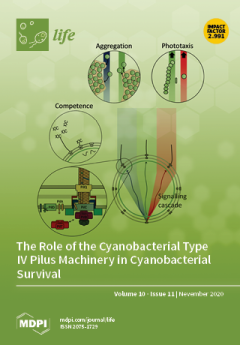Life cannot emerge on a planet or moon without the appropriate electrochemical disequilibria and the minerals that mediate energy-dissipative processes. Here, it is argued that four minerals, olivine ([Mg>Fe]
2SiO
4), bridgmanite ([Mg,Fe]SiO
3), serpentine ([Mg,Fe,]
2-3Si
2O
[...] Read more.
Life cannot emerge on a planet or moon without the appropriate electrochemical disequilibria and the minerals that mediate energy-dissipative processes. Here, it is argued that four minerals, olivine ([Mg>Fe]
2SiO
4), bridgmanite ([Mg,Fe]SiO
3), serpentine ([Mg,Fe,]
2-3Si
2O
5[OH)]
4), and pyrrhotite (Fe
(1−x)S), are an essential requirement in planetary bodies to produce such disequilibria and, thereby, life. Yet only two minerals, fougerite ([Fe
2+6xFe
3+6(x−1)O
12H
2(7−3x)]
2+·[(CO
2−)·3H
2O]
2−) and mackinawite (Fe[Ni]S), are vital—comprising precipitate membranes—as initial “free energy” conductors and converters of such disequilibria, i.e., as the initiators of a CO
2-reducing metabolism. The fact that wet and rocky bodies in the solar system much smaller than Earth or Venus do not reach the internal pressure (≥23 GPa) requirements in their mantles sufficient for producing bridgmanite and, therefore, are too reduced to stabilize and emit CO
2—the staple of life—may explain the apparent absence or negligible concentrations of that gas on these bodies, and thereby serves as a constraint in the search for extraterrestrial life. The astrobiological challenge then is to search for worlds that (i) are large enough to generate internal pressures such as to produce bridgmanite or (ii) boast electron acceptors, including imported CO
2, from extraterrestrial sources in their hydrospheres.
Full article






